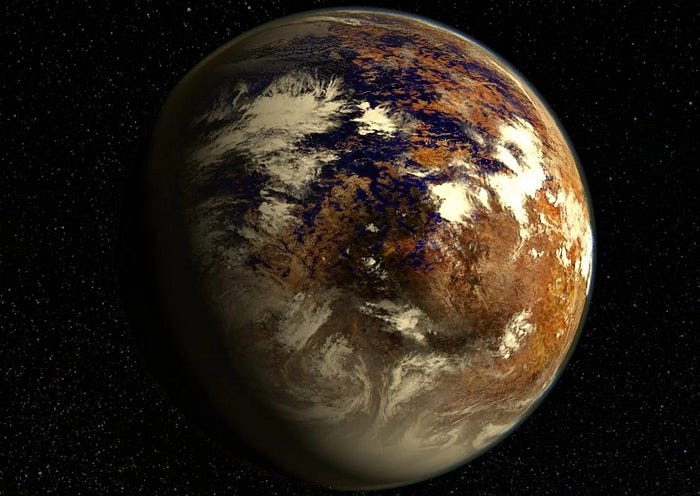In the vast expanse of the universe, there exists a cosmic neighbor, Proxima Centauri b, that beckons us to contemplate the wonders of the cosmos and the potential for life beyond our solar system. Situated just over four light-years away from Earth, in the Proxima Centauri star system, this enigmatic exoplanet holds the promise of being a terrestrial world with conditions ripe for the emergence of life. Join us on a journey to explore Proxima Centauri b, from its intriguing characteristics to the tantalizing quest for extraterrestrial life.

1. Characteristics of Proxima Centauri b:
- Size:
Proxima Centauri b, often referred to as Proxima b, stands as an Earth-sized exoplanet, sharing similarities with our home planet. It boasts a mass approximately 1.3 times that of Earth, categorizing it as a terrestrial exoplanet.
- Orbit:
In the cosmic ballet, Proxima Centauri b twirls around its parent star, Proxima Centauri, at an astonishingly close distance. It completes one orbit in a mere 11.2 Earth days, a stark contrast to our year-long journey around the Sun.
- Habitability:
The most captivating facet of Proxima Centauri b lies in its location within the habitable zone, also known as the Goldilocks zone, of its star. Within this realm, the conditions for liquid water to exist on the planet’s surface — a fundamental ingredient for life — are tantalizingly possible.
2. The Enigmatic Atmosphere:
While Proxima Centauri b beckons with its potential for habitability, the secrets of its atmosphere remain shrouded in cosmic mystery. Detecting and deciphering exoplanet atmospheres, particularly those as distant as Proxima Centauri b, present formidable challenges, necessitating advanced telescopes and instruments.
The atmosphere, a vital player in the habitability game, governs temperature, shields against radiation, and may cradle the essential building blocks of life.
3. The Quest for Extraterrestrial Life:
Proxima Centauri b has stirred the hearts of scientists and space enthusiasts alike in the quest for extraterrestrial life. Its proximity to Earth and placement within the habitable zone make it a prime candidate for exploration. Scientists are eager to study exoplanets like Proxima Centauri b because they offer a window into the potential for life beyond our solar system.
The search for extraterrestrial life extends far and wide, encompassing the study of exoplanets both within and outside the habitable zone. It hinges on the hunt for signs of habitability and biomarkers — indicators such as water, oxygen, and methane — within exoplanet atmospheres.
The discovery of life, if it exists, on Proxima Centauri b or any other exoplanet would be an epochal scientific achievement, reshaping our understanding of life’s prevalence in the universe.
4. A Comparative Gaze at Proxima Centauri b and Earth:
To appreciate Proxima Centauri b fully, let’s draw parallels between it and our beloved Earth:
- Size and Mass:
Earth: A familiar orb with a mass of roughly 5.972 × 10²⁴ kilograms, characterized as a terrestrial planet.
Proxima Centauri b: Earth-sized and terrestrial in nature, with a mass about 1.3 times that of Earth.
- Parent Star and Orbit:
Earth: In a cosmic ballet around the Sun, a G-type main-sequence star, at an average distance of about 149.6 million kilometers, completing one orbit in 365.25 days.
Proxima Centauri b: Dances around Proxima Centauri, a red dwarf star, in an orbit just over 7.5 million kilometers from its host star, completing an orbit in 11.2 Earth days.
- Habitability and Atmosphere:
Earth: Graced with a diverse and life-sustaining atmosphere, primarily composed of nitrogen (about 78%) and oxygen (about 21%), with trace gases, fostering a rich tapestry of life.
Proxima Centauri b: Conceals its atmospheric secrets, awaiting the advances of science to unveil its composition and properties.
- Potential for Extraterrestrial Life:
Earth: A vibrant hub of life, teeming with everything from microorganisms to complex multicellular organisms, including Homo sapiens.
Proxima Centauri b: Nestled within the habitable zone, sparking the imagination with the potential for life, while the existence of life on the exoplanet remains speculative, awaiting further research.
As we gaze upon the cosmic neighbor, Proxima Centauri b, it serves as a beacon, guiding our yearning for exploration and discovery. Although it remains a distant dream for human visitation, its existence ignites our quest to unravel the cosmic enigmas and unveil the mysteries of life beyond our terrestrial shores. The quest for life beyond Earth endures as an enduring testament to human curiosity, the spirit of exploration, and the relentless pursuit of knowledge in the vastness of the cosmos.










